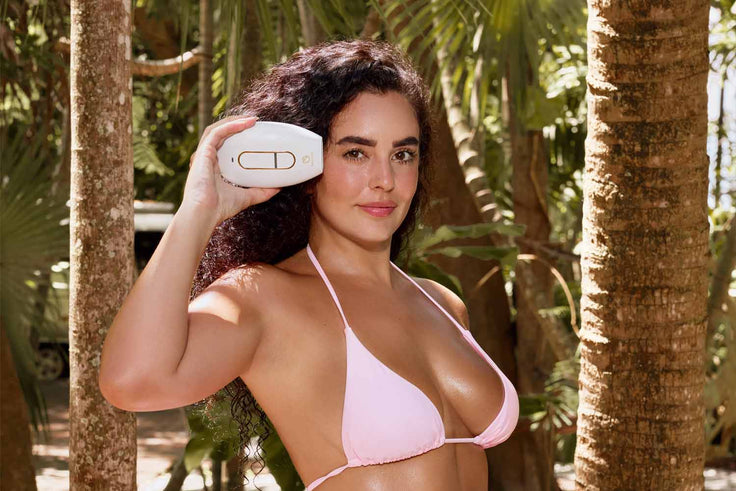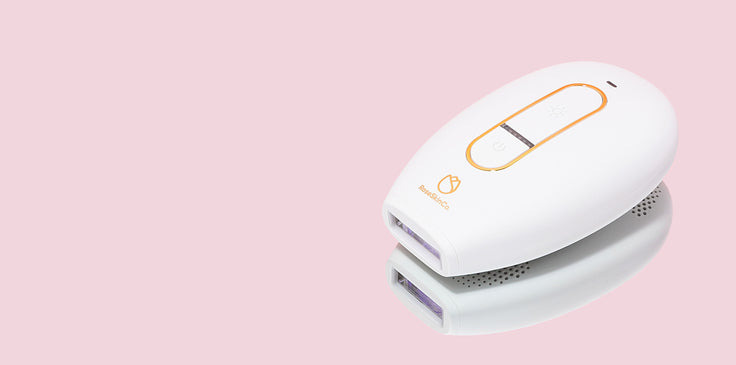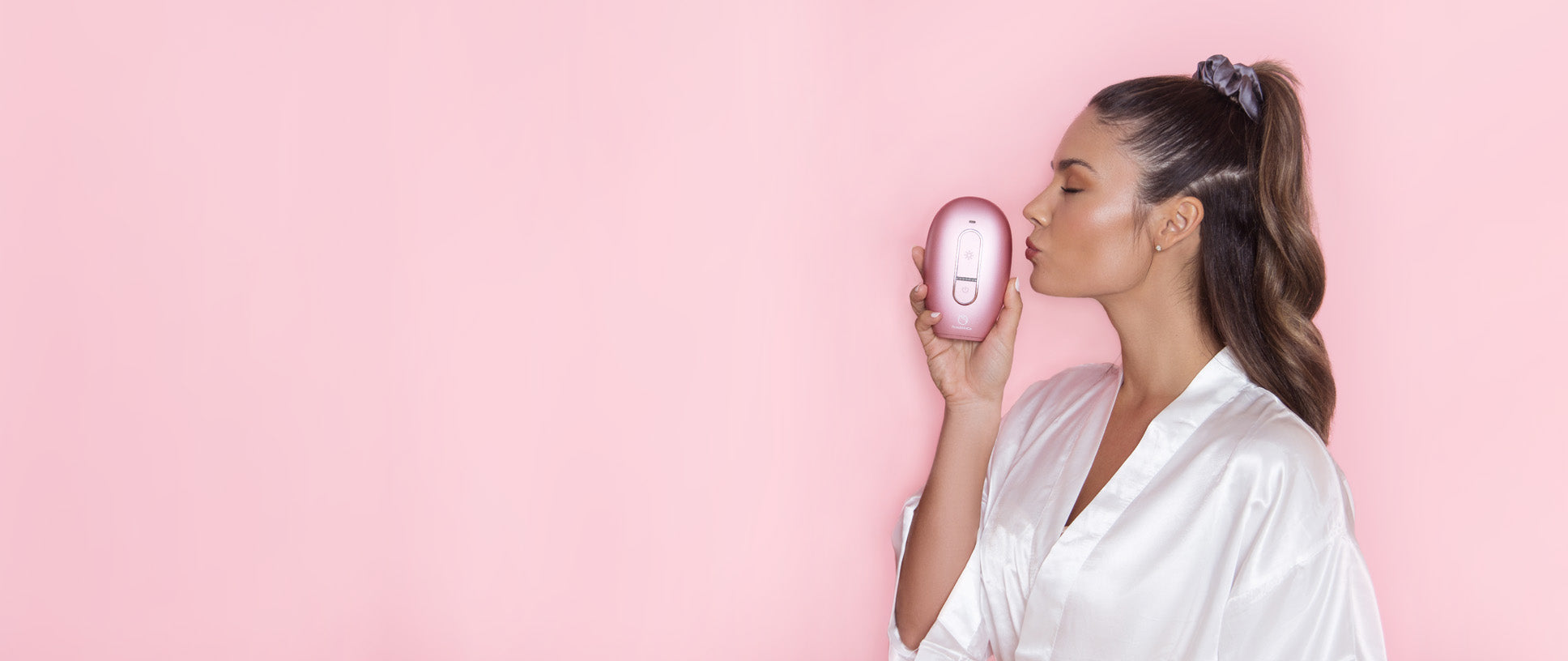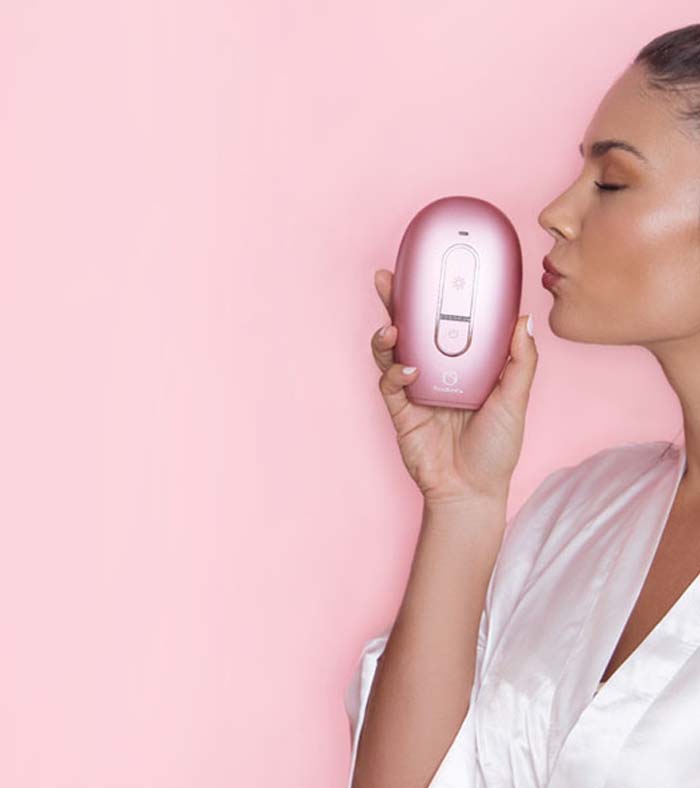Removing bikini hair can be a painful process… but having rogue hairs peek out of your cute new swimsuit? That’s a whole different type of pain 😅
The pain and discomfort too often associated with bikini hair removal can be SOOOO frustrating. And even though reportedly 84% of women groom their pubic hair, it can still be really hard to find a reliable, effective way to do so. But whether you’re sick of down-there razor burn, you’ve resolved never to get a Brazilian again, or you wish you could quit having to deal with pubic hair for good, you’re in the right place.
The good news? Not all bikini hair removal is gonna make you scream or wince or swear with pain. And with the latest advancements in bikini hair removal technology, like IPL, you can get pain-free permanent hair removal from the comfort of your home.
We’ve gathered ALL of the major bikini hair removal methods out there and ranked them by effectiveness and pain level. Let’s get into it!
TL;DR: Bikini Hair Removal Methods, Ranked from Most to Least Painful
What's the best way to remove pubic hair?
One thing about hair removal for the bikini area: you’ve got OPTIONS. While they vary in terms of pain level, how long results last, whether you can do it at home, and MANY other factors, they’ll all at least take you from bushy to less bushy, at least for a little while.
Some of these coarse bikini hair removal methods you may already be familiar with, others you may not be aware of.
Here’s our list, in order of most painful to least painful, along with notes and tips on how they specifically apply to bikini hair removal.
**Quick disclaimer** – Pain levels are subjective. These ratings aren’t scientific, just based on personal and crowdsourced experience!
Top 7 Bikini Hair Removal Methods (ranked by pain)
1. Epilating
Pain level: 4.5/5
Epilators are mechanical devices that essentially pluck patches of your hair out at once. While tweezing requires you to go hair by hair, an epilator grabs multiple hairs at the same time and yanks them all out at once.
Since epilators take the entire hair follicle out, the results last longer than shaving — about 3-4 weeks for most people. But the thing is, epilating HURTS, especially at first. Many people report that over time, treated hairs get thinner and your skin gets used to it, but it’s often reported to be one of the most (if not THE most) painful methods of hair removal.
2. Laser Hair Removal
Pain level: 4/5
Laser hair removal utilizes a concentrated beam of light to destroy hair at the follicle and prevent future hair growth. It should only ever be performed by a professional. It’s a very effective way to remove unwanted pubic hair… and remove it for good.
But laser hair removal hurts. Reports of pain levels vary – some describe it as the worst pain they’ve ever felt, others say it’s painful but nothing unbearable. It may hurt more or less depending on skin sensitivity, the coarseness of your hair, and your pain tolerance.
Why do we rank laser hair removal below epilating? Most report that laser hair removal hurts less after a few treatments since laser hair removal works gradually and there’s less hair to treat with every session. But more importantly, laser hair removal is permanent hair removal. After a full laser hair removal treatment regimen, having smooth, hair-free skin down there won’t require any pain at all.
That being said, it can also be painful to part with the cash required. Laser hair removal requires multiple sessions to offer full results, and fully treating the bikini area can easily cost thousands of dollars.
3. Waxing
Pain level: 4/5
The bikini hair removal OG – there’s even a special type of wax named after it. But does it deserve to be the bikini hair removal go-to? Nowadays, that’s debatable.
You probably know the drill – you put hard wax or wax strips on your pubic hair, then rip the wax off and your hair with it.
Bikini waxes usually go down at a salon. (It’s possible to DIY, but there’s something about at-home pubic hair removal that always ends up in a sticky mess. Speaking from experiences, some sort of self-preservation instinct kicks in when you’re about to inflict serious pain on your own lady parts.)
The process itself? Painful. You’re ripping your hair out. (Though it can be less painful over time, as your hair grows back thinner.) And then, the skin usually remains tender for 24-48 hours afterward, in some cases resulting in burns, ingrown hairs, or irritation.
There’s no way around it: bikini waxes are notoriously OUCHY. If avoiding pain in your bikini hair removal regimen is important to you, you might want to steer clear of this one.
4. Tweezing
Pain level: 3/5
Pluck, pluck, pluck, repeat. Tweezing is easy, effective, and affordable. Literally all you need is a tweezer.
Tweezers are designed to pluck hairs out right from the root. Since the tweezers take the entire hair follicle out, including the root, it takes a while for the hairs to grow back.
But you know what else takes a while? Tweezing. If you’re trying to remove all of your bikini hair with a pair of tweezers, prepare to block an hour or ten on your calendar.
Tweezing may not be as painful as other down-there hair removal options, but man... tweezing itself is a PAIN. That being said, tweezing can totally have a place used in conjunction with other hair removal methods, whether you’re removing a few stragglers after a professional wax or getting into the nooks and crannies your razor can’t reach. But typically, tweezing works better for smaller, more precise areas, like eyebrow hair.
5. Shaving
Pain level: 3/5
You know it, you’re fine with it, you’ve probably done it before. Shaving is common for a reason – it’s easy, it’s affordable, and it can be done anywhere.
The cons? Razors aren’t exactly designed with coarse pubic hair or lady bits in mind. You may leave a shaving sesh with battle wounds – and you might not be able to achieve a close enough shave to get smooth for longer than a few hours.
Shaving is a tricky one to categorize pain-wise. When everything goes right, it can be relatively painless.
But more often than not, all doesn’t go right– shaving down there often involves ingrowns, nicks, cuts, and bumps that not only make shaving & existing after shaving painful, but also create a vicious cycle: shaving causes painful cuts and ingrowns that make shaving next time even more painful, and so on.
6. Depilatory Creams
Pain level: 2/5
Also known as hair removal creams, depilatory creams use chemicals to break down the proteins in your hair and make them fall out. They’re relatively painless in most cases, but we do recommend choosing a formula designed for hair removal for the bikini area and doing a patch test before treatment as in some cases these creams can cause burns or severe irritation on sensitive skin.
Like shaving, depilatory creams only remove hair at the surface of the skin, not at the root. This means results don’t last long, especially when it comes to coarse bikini hair removal. Still, it’s a decent way to remove pubic hair without shaving!
7. IPL
Pain level: 1.5/5
Wondering how to remove hair from your private parts permanently and in a pain-free way? IPL’s your answer.
IPL stands for intense pulsed light. It is a form of light therapy that is very similar to laser hair removal, but there are some key differences.
While laser uses one single-spectrum light, IPL uses broad-spectrum light pulses to destroy unwanted hair follicles without damaging the skin. This less-targeted approach makes IPL treatment less painful than laser hair removal and safe to DIY at home. At-home IPL devices like Lumi also feature advanced cooling technology and multiple intensity levels for comfortable, customizable treatment.
Like laser hair removal, IPL gets extra points because it provides permanent pubic hair removal. The minimal pain experienced during IPL treatment should definitely be considered, but really it’s an investment. After a full treatment regimen of 8-12 weeks, your bikini hair removal routine shouldn’t involve any pain at all. You’ll be smooth and hair-free down there for good!
That being said, IPL is not a fit for everyone. IPL technology requires contrast between the hair and skin to target the hair follicle, so it’s not suitable for very dark skin or very light hair.
In our opinion, this is the best hair removal for the bikini area.
Your Burning Questions About Removing Hair Down There, Answered
What is the least painful method for bikini hair removal?
IPL is the least painful bikini hair removal method. Other less painful methods include depilatory creams and shaving. Your pain experience may vary depending on your tolerance, skin sensitivity, and coarseness of hair.
How can I prevent ingrown hairs after pubic hair removal?
For one, the method you use for bikini hair removal matters – shaving is notorious for causing ingrown hairs, for example. But with any hair removal method, proper aftercare can help. We recommend moisturizing the skin immediately following hair removal and exfoliating in the shower in between bikini hair removal sessions.
Is it safe to remove bikini hair at home?
Yes! Not EVERY bikini hair removal method is safe to DIY at home – laser hair removal should never be performed at home, and waxing to remove bikini hair at home may not yield the best results. But many other bikini hair removal methods are perfectly safe to do at home, including IPL.
How often should I remove pubic hair to maintain smooth skin?
This depends on the hair removal method you use.
- For shaving or depilatory creams – every couple of days, maybe even every day if your hair grows fast. Some struggle to achieve totally smooth skin using these methods at all, even immediately after hair removal.
- For waxing, epilating, or tweezing – often every couple of weeks. Some regrowth in between treatments is required for treatment.
- For laser hair removal – this involves multiple treatments spaced out a few weeks apart and can take up to a year for full results. But you can use other hair removal methods in between treatments to maintain smooth skin in the meantime, and after full laser hair removal treatment, your skin should be permanently smooth!
- For IPL hair removal – once or twice a week for 8-12 weeks. You can shave in between treatments to maintain smooth skin in the meantime. After that, your skin should be permanently smooth!
Can bikini hair removal cause skin irritation or allergies?
Yes, especially certain methods. Hot wax and depilatory creams may cause burns, allergic reactions, or other skin irritation on sensitive skin. Other methods like tweezing, epilating, and laser hair removal can cause irritation as well.
IPL bikini hair removal is typically very gentle, especially at its lowest setting. That being said, everyone is different – if your skin is extremely sensitive or if your skin color/hair color makes you not a good candidate for IPL hair removal, it may not work for you.
What are the long-term effects of regular hair removal?
This depends on the method you use.
- Shaving/depilatory creams – No/minimal long-term effects.
- Waxing/tweezing/epilating – Can cause the hair to grow back thinner over time, but not a permanent hair removal method.
- Laser/IPL – A permanent reduction in body hair.
How do I choose between laser hair removal and IPL for the bikini area?
Great Q! Usually, the question of IPL vs laser hair removal comes down to budget & convenience.
If you’ve got the $$$, the time, and a decent pain tolerance, laser hair removal can be a great option. A professional will take care of it and you’ll see great results.
Lumi IPL is a more affordable one-time cost, you can do it at home, and – bonus – it works on other body parts too, at no additional cost. It’s also less painful than laser hair removal.
Are there any natural or DIY methods for bikini hair removal?
This depends on what you mean by natural! We’re not aware of any supplements or herbal medicines that result in bikini hair removal. But if you’re looking for something chemical-free, ditch depilatory creams, waxing, and shaving and consider epilating, tweezing, laser hair removal, or IPL. Sugaring, a hair removal method that uses a mixture of lemon, water, and honey, might also be worth looking into.
As far as DIY goes – that’s a yes. Laser hair removal should never be DIYed, and waxing yourself at home can have mixed results, but other methods like IPL, epilating, tweezing, and shaving can definitely be done on your own at home.
What should I do before bikini hair removal for the best results?
Proper pubic hair removal prep depends on the method you use:
- For IPL/laser – shave the area you’re going to treat first.
- For waxing/epilating – consider trimming the hair a bit if it’s really long. Keep in mind that hair should be grown out to ⅛-¼ inch beforehand.
- For shaving – use shaving cream.
- For depilatory creams – follow the instructions on the bottle.
No matter the bikini hair removal method you use, exfoliating 24 hours before treatment can help improve results.
How can I manage pain or discomfort during bikini hair removal?
Here are a few tips:
- Choose a less painful method to begin with.
- Listen to your body – stop if it’s too much, don’t just grit your teeth and power through it.
- Consider taking an over-the-counter pain reliever before and/or after treatment.
- For really sensitive skin, consider removing less bikini hair – perhaps prioritize bikini line hair removal rather than going for a whole Brazilian look. Try using underwear or your favorite bikini bottoms as a template and focus on only removing hair that peeks out.
- Time hair removal around your menstrual cycle. Skin sensitivity tends to be heightened during menstruation.
Sources:
- https://jamanetwork.com/journals/jamadermatology/fullarticle/2529574





